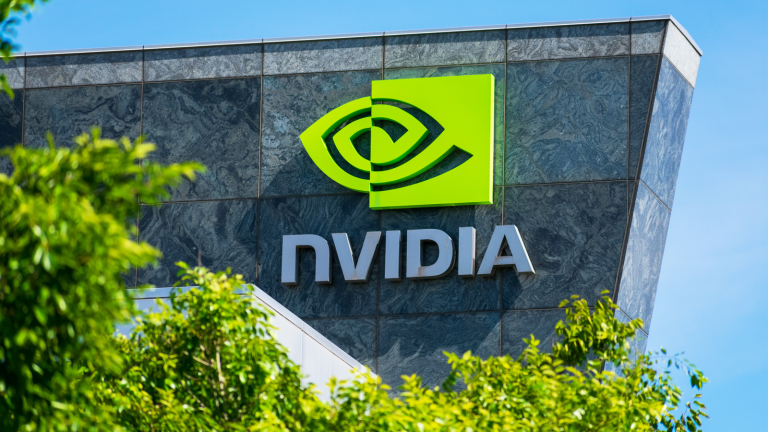Back in January, Wall Street did what Wall Street often does.
It hit the panic button.
The trigger? A flurry of headlines out of China hyping a new AI project called DeepSeek.
A week earlier, DeepSeek released a new AI model called R1, claiming it to be on par with OpenAI’s o1-mini model for ChatGPT. It utilized inferior NVIDIA Corporation (NVDA) chips, called H800s, that were compliant with the export bans to China.
Adding insult to injury, the company claimed it was built in about two months and cost just $5.6 million to train.
After grabbing headlines around the world, DeepSeek temporarily claimed the number-one spot for downloaded apps on the Apple Inc. (AAPL) App Store.
On January 28, NVIDIA’s stock fell off a cliff – by 17% in one day to be exact.
Nearly $600 billion in market cap vanished. Just like that.
It would be the single largest drop in market cap in Wall Street’s history.
But the bloodbath didn’t end there. The stock went on to drop further, wiping out about a third of the company’s value.
Wall Street Panicked – I Didn’t
The media rushed to call it a threat to U.S. chip dominance. But I told readers at the time that this wasn’t a real challenge to NVIDIA’s leadership. Not only was I skeptical about DeepSeek’s claims (there was a very real possibility this was a propaganda stunt). But if anything, this would lead to more demand for NVIDIA’s chips, not less.
Then came round two – this time on April 20.
That’s when President Trump made the Liberation Day tariff announcement.
As rumors swirled about President Trump slapping new tariffs on Chinese tech and restricting AI chip exports, traders got jittery again. More volatility. More headlines.
Eventually, the stock would bottom out just below $95 – a total drawdown of nearly 40% from NVIDIA’s previous highs.
For some, it was too much to bear. But, again, I stayed calm and urged restraint. I explained why these policies wouldn’t hurt the AI leaders here in the U.S. I explained how the end goal was more trade, not less. And fairer trade, where U.S. companies were on a more level playing field with their foreign counterparts.
And now? NVIDIA is not only back – it’s back on top.
Since bottoming out in early April, the stock has surged by more than 65% to hit new all-time highs and become the most valuable company on the market.
All in less than three months.

How I Nailed My Call on NVIDIA
While everybody was panicking about DeepSeek and tariffs, NVIDIA was cutting deals and setting the stage for the next wave of the AI Revolution.
In May, NVIDIA CEO Jensen Huang joined President Trump on a tour of the Middle East. The highlight? NVIDIA announced plans to sell over 18,000 Blackwell chips to Saudi Arabia’s state-backed AI firm, HUMAIN. These chips will power an entire national AI cloud. And the UAE is expected to follow with similar partnerships.
I covered these developments in Market 360 on May 23, close to NVIDA’s bottom. In that same issue, here’s what I told readers:
If you’ve been a longtime reader of mine, you know NVIDIA has been and continues to be the shining star. I’ve gone on record saying it is the “stock of the decade,” and I stand by that. It remains far and away the leader of the AI Revolution.
And it clearly shows no signs of slowing down, either.
Turns out, that call was pretty spot on. If you look at the chart above, you can clearly see it was up, up and away from there.
The reality is that my commitment to NVIDIA never wavered. In fact, I repeatedly told my premium readers it was a “screaming buy.”
So, what happened? Did I just get lucky?
Far from it. I called NVIDIA’s rebound because I’ve seen this movie before.
As I’ve said many times before, Wall Street is a manic crowd that likes to panic first and think later. Because, as it turns out, the growth runway for NVIDIA is still incredibly long.
NVIDIA Is Thinking Beyond Chips
See, NVIDIA is turning into a lot more than just an AI chipmaker.
It’s the platform – the foundation layer for the entire AI economy.
Consider what Huang told shareholders at the company’s 2025 annual meeting just this week:
“We’ve stopped thinking of ourselves as a chip company,” Huang said. “We’re working towards a day where there will be billions of robots, hundreds of millions of autonomous vehicles, and hundreds of thousands of robotic factories that can be powered by NVIDIA technology.”
To back that up, NVIDIA disclosed at the same meeting that GPU sales have surged to $130.5 billion in the past year – up from just $27 billion in fiscal year 2023.
And while that’s impressive, Huang made clear that chips are just one piece of the puzzle. It’s AI and robotics that now represent the company’s two largest multi-trillion-dollar opportunities.
And here’s the thing. Robotics is about much more than humanoid robots (although that’s coming, too.)
Think of it in terms of AI exploding into the real world.
The Physical AI Boom Is Here
For example, in yesterday’s Market 360, I wrote about the launch of Tesla Inc.’s (TSLA) first live robotaxi service – and how the entire driverless industry is shifting into high gear.
It’s a space with trillion-dollar potential, and everyone wants a piece – from Google (Waymo) to Uber Technologies Inc. (UBER) to Amazon.com Inc. (AMZN) and more.
But as I said, here’s what most people are missing: NVIDIA is the one getting paid no matter who wins.
Now, their self-driving segment is a small piece of the pie, but it’s growing fast. In fact, it brought in $567 million last quarter – up 72% year-over-year.
Tesla, Waymo, Zoox, Baidu, Inc. (BIDU) – odds are they’re all using NVIDIA’s platforms to train models, process video feeds, and make real-time decisions in traffic. NVIDIA’s Drive stack is quietly becoming the standard operating system for autonomous mobility. And with robotaxis rolling out across the U.S. and Asia… this is just the beginning.
Now let’s talk robotics.
NVIDIA is helping machines move, think and act in the real world.
One of the most exciting projects is called Isaac GR00T – a foundational model built to train humanoid robots on real-world tasks. Combine that with Isaac Sim (a digital simulation environment) and Jetson (a compact AI chip for robotics), and you’ve got a full pipeline: from AI model… to training ground… to deployment.
Imagine robots that can learn by watching a person sweep a floor. Or re-stack shelves in a warehouse without needing to be reprogrammed every time the layout changes.
Now, imagine those robots starting to do more complex tasks. Like repairing broken-down equipment in a remote facility. Or assisting with surgical procedures in real time.
That’s where this is headed – and NVIDIA is selling the entire toolkit.
The Next Profit Window Is Opening Now
The bottom line is the future is coming a lot quicker than you may think.
It’s about to get a lot more interesting, too.
And it you position yourself correctly – a LOT more profitable.
That’s why I’ve been watching a new AI tool from our partners at TradeSmith.
It’s called TradeSmithGPT, and it uses AI to spot what it calls a stock’s “profit window” – the short stretch of time when a stock is most likely to surge based on real-time data and predictive analytics.
This isn’t some trend-chasing toy. It analyzes over 120 million datapoints across 2,400 stocks and can forecast high-confidence setups weeks in advance.
Right now, TradeSmithGPT is flashing three high-upside trade alerts for July 1.
If you want to make the most of this AI-driven market – especially the fast-moving kind we’re in now – this tool could be your edge.
Don’t wait for the next breakout to pass you by.
Sincerely,

Louis Navellier
Editor, Market 360
The Editor hereby discloses that as of the date of this email, the Editor, directly or indirectly, owns the following securities that are the subject of the commentary, analysis, opinions, advice, or recommendations in, or which are otherwise mentioned in, the essay set forth below:
NVIDIA Corporation (NVDA)

